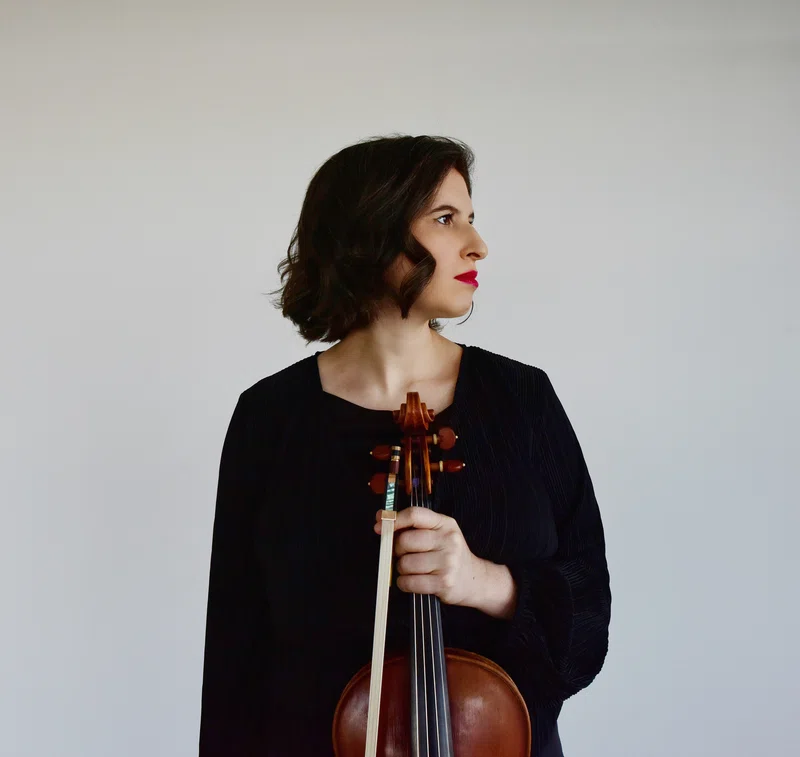©2023 Ohio Music Education Association



FEATURED ARTICLES
Tips for a Successful Viola Pedagogy: Setting up a Balanced and Flexible Left Hand
Tips for a Successful Viola Pedagogy: Setting up a Balanced and Flexible Left Hand
Dr. Hannah Levinson

Dr. Hannah Levinson
The viola is often considered the awkward sibling of the string instruments – it’s played like a violin, yet its proportions lead to technical and physical obstacles that players need to overcome to create its rich, signature sound. If you also consider that the measurements of a full-size viola are not standardized (its length can range anywhere from 15 to 17 inches, and that doesn’t even take into account differences in width!), one quickly discovers that a “one size fits all” approach to viola pedagogy is both literally and figuratively impossible.
These unusual attributes require violists to do a lot of maneuvering to play at an advanced level, necessitating a technique that is more closely related to cello pedagogy than violin. Yet, in school settings, violists are often lumped together with the violins and offered a general upper strings music education. While this approach can be successful for beginning and intermediate students, it frequently results in gaps in knowledge and technical facility as students advance. In this article, I would like to offer a few tips and exercises to develop a flexible left-hand technique specific to the viola.
The Constantly Rebalancing Hand
The Constantly Rebalancing Hand
Because every violist deals with a unique combination of their personal physiology and the size of their instrument, each player’s left hand may function slightly differently. For many violists, first position is extremely large and players may use “mini-shifts” in order to play first and second finger notes vs. third and fourth, actively rebalancing their hand as they play. To achieve this, the hand frame needs flexibility to allow for these micro-movements. This means that though the most common approach to setting up the violin left-hand starts with the first finger and builds upwards from there, the violist’s hand frame actually benefits from setting up from the fourth finger (pinky-side of the hand) and working backwards towards the first finger.
Shifting the balance towards the fourth finger creates flexibility by allowing for more stretch within the hand. To try this out, experiment with holding your left hand in playing position. Imagine setting up from the first finger – you may find that the stretch to the fourth finger requires you to push the wrist outwards in an undesirable way. Yet, if you set up from the fourth finger, the “stretch” back to the first finger is a more flexible movement and allows for your wrist to remain in a neutral, slightly inward position, helping to maintain your hand frame.
On the instrument, you can practice descending scale patterns starting from the fourth finger to feel the release in the base knuckles as you stretch towards the first finger. To find the neutral wrist position, it can also be helpful to set up the hand frame in third position and then shift back into first.
The Mobile Thumb
The Mobile Thumb
Generally, upper strings are taught to create a circle between their pointer finger and thumb and then insert the fingerboard and neck of the instrument as part of the circle, with the thumb directly across from the first finger. But, if the advanced violist is constantly rebalancing their hand depending on the passage, the thumb cannot stay rigidly in place. Instead, the thumb needs to be loose and mobile to support the hand. Again, this is especially true in lower positions, depending on the size of your instrument and hand. For example, my thumb has a general homebase across from the first finger but moves towards the second finger to create more flexibility when I play with my third or fourth fingers.
A benefit of developing a flexible thumb is that it can also reduce thumb tension (an unmoving thumb tends to grab). To develop this mobility, you can play passages while shadowing the finger pattern with the thumb (i.e. if you were playing 1, 2, 3, 4, your thumb would follow those fingers up and down the opposite side of the neck).
You can also make little circles with your thumb while playing scales, etudes, repertoire, etc., to practice releasing the grip of the thumb on the neck.
Releasing the Fingers
Releasing the Fingers
You may be thinking that this flexible left-hand technique seems to come into direct opposition to another principle frequently taught to upper string students – keeping your left-hand fingers down. While this can be a very helpful tool to develop a hand frame with good intonation, when fingers remain down, tension remains trapped in parts of the hand which are not actively engaged in playing notes, which disrupts the ability to rebalance towards the finger that needs support. While I don’t advocate for letting fingers fly back into the air, advanced violists need to learn to release their fingers at the base knuckle joint when they are not being actively engaged.
This quick release (as if you are touching a hot stove) can be practiced on a surface away from the instrument and then incorporated into scales and etudes.
Fingers should remain close to the fingerboard so they are “in place” when they are needed again. As a bonus, releasing the base knuckles while keeping your fingertip on the string (and not keeping all the fingers down) is essential to a great vibrato!
Conclusion
Conclusion
My college freshman often exclaim, “How did I get this far without knowing this?!,” when first introduced to viola specific concepts, especially if they never had private lessons. While it may be hard to imagine how to introduce these concepts to beginners, I encourage you to lay the groundwork by teaching your students how to recognize and release tension in their hand. I hope these tips begin to offer some insight into the technical nuances of viola playing and help you consider ways to prepare young violists for their future playing needs.
Dr. Hannah Levinson is the Assistant Professor of Viola at Bowling Green State University. She is the Executive Director and co-founder of the violin/viola duo, andPlay, a member of the Talea Ensemble, and frequently performs with other contemporary and classical ensembles. Before moving to Ohio, she was on faculty at New York University and the Manhattan School of Music Precollege.




